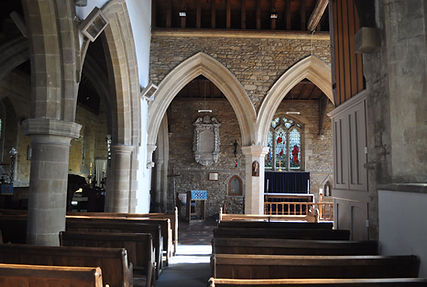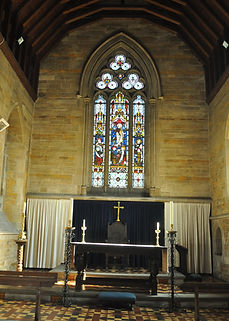It was a glorious March afternoon in 2022, and day off of work and a full day’s Leicestershire churchcrawl. This was the third church of the day, having previously visited Hallaton and Horninghold, whilst waiting for the church of St Giles to open. Both had been open to visitors and it had been a good start to the day.
I had visited the church here at Medbourne back in 2014, on a dull dreary Saturday. The church was open as they prepared for a wedding later that day. We were welcomed in and took some photos, but the light quality on the day was really poor. This is a glorious church and I wanted to see it in better lighting conditions; it took a mere seven and a half years to sort out the return visit! No point in rushing. A check beforehand had established that the church would be open and we were good to go!
Medbourne is a pleasant village which had a population of 490 at the time of the 2021 census. We are in beautiful Leicestershire countryside here, but fairly close to the Rutland border, with Uppingham, Rutland’s second largest settlement being seven miles or so off to the north east. The Northamptonshire border is also not too many miles away with Corby nine miles away to the south east.
Medbourne takes on Hallaton each year, on Easter Monday, in a bottle kicking event. The aim is to take the bottle, on a best of three basis, from Hare Pie Bank and across the respective village boundary streams, the team that crosses their own boundary stream with the bottle wins There are no rules, no referee, and no limit on players. Well, there are rules in as much as no weapons are allowed! These eccentric traditions occur the length and breadth of Great Britain; much to the amusement and bemusement of the rest of the world!
There wasn’t a cloud in the sky as I assumed the position leading against the churchyard wall, shooting the church from the south. I was joined by another photographer, also shooting the church; he being a landscape photographer. We enjoyed what we saw before us, with the daffodils out in full bloom and the church providing a beautiful backdrop. This is a lovely setting; a path surrounding the church which leads to a bridge, which goes over Medbourne Brook, to the west of the church. This bridge was built in 1820 and has its own Grade II Listing.
Also of great interest was the village shop nearby, and in particular the deli counter. The few people that we saw were friendly. This give every impression of being a very lovely village. It was good to see it again.
The church that we each saw before us is cruciform in structure; consisting of west tower, nave with south aisle, north and south transept, south porch and chancel. It dates back as far as the 13th century. The thought is that this was intended to be a cruciform church with central tower, these plans abandoned in favour of a west tower.
The square ironstone tower is buttressed and battlemented with clock facing out from the south face. The lower parts of the tower date from the 13th century with the upper stage dating from the 15th century.
The south side of the church is dominated by an enormous south transept, which dates from the late 13th century. This has a fine five light window, with intricate tracery. The south porch is small in comparison, dating from the 17th century.


As was promised, the church was open to visitors. Moving in through the south, it was bright and welcoming inside. Standing at the west and looking towards the chancel, this is an unusual layout. The south arcade is of three bays, which leads to the south transept which has three bays running from north to south. It is rarely that I have been in to a church which has bays within the transept!
The chancel was rebuilt in 1876. But there are still features from the chancel before the rebuilding. Against the south wall there is a triple sedilia, the seating for the priests during the Mass. Interestingly, the most easterly of the seats is raised higher, with a higher seat for a more holy person. Further to the east of the south wall of the chancel are two piscine, which would have been used in the washing of the holy vessels, which were used during the mass.
A close look here shows a bottle of hand sanitiser in the sedilia; ideal dating evidence for anyone wanting to date these photographs in future generations. Hand sanitiser would date this to 2020 or the years immediately after! The reredos here takes the form of a cream coloured curtain, which becomes blue as it goes behind the altar.
The east window is of three lights and has a stained glass depiction of the ascension. Jesus stands on a cloud, with wounds visible on hands and feet, with six disciples below. The script at the foot of this window concludes by saying that ‘he was parted from them and carried up in to Heaven’.





In to the south transept, which dates from the late `13th century, there is stained glass in a three light east window. This has a depiction of the risen Christ central, flanked by St Giles and Doctor Watts. St Giles, after who the church is dedicated, is on crutches and is shown with a hind deer. St Giles is the Patron Saint of those with physical disability; with legend stating that he once saved a hind deer from the Kings hounds. Doctor Watts is William Watts, who was the curate in charge here for many years and who founded the Leicester Royal Infirmary.
Flanking this east window is a piscina and aumbry and against the south wall of the south transept is a badly damaged effigy of a priest dating from the 14th century. This rests in a tomb canopy and a skeleton was found here when work was undertaken here in 1911. Stone human heads can be seen at the north end of the south transept, with two interlocking male figures, who looked as if they may be wrestling and a solitary male figure with impressive beard. A simple floor slab to Edwd Conyers Esq notes the final resting place of himself, his wife Sarah and daughter Sarah.






There is just one other item to note; this being a gravestone leaning up against a wall, which someone has thought interesting enough to save. The gravestone is to John Carter who died in 1705. In very weathered script it reads ‘Prepare young men to follow me. As I am so must you all be’. In script, this is saying the same as is said in symbol form on other gravestones. Many stones have memento mori symbols of them; symbols such as the human skull, human bones, the gravedigger’s tool of pick and shovel. All of these are symbols of the fragility of human life; the mortality of Man. Others have hour glasses, some with wings' 'Tempus Fugit' time flies.
These, whether in script or symbol form, remind the onlooker that Man is mortal and will die. Therefore, live a good Christian life, trust in God and do not be caught lacking when your own time comes. In days of high mortality rate and low life expectancy, your own time could be nearer than you think.
With regards John Carter, people of his generation would have been surrounded by death for their entire lives. If he had lived to a decent age he would have been alive during the English Civil War in which an estimated 200,000 died, this equating to 4.5% of the population and he could well have lived through the Bubonic Plague which ravaged the country from 1665 to 1666, with huge death toll and fear throughout the country. There is an old Chinese curse which reads ‘May you live in interesting times’ Carter certainly did!



The church grounds are large and well maintained; with one item in the grounds having its own Grade II Listing. This is the stump of a medieval churchyard cross, which can be found close to the south porch. The grounds are interesting, with many slate gravestones as you would expect from this part of the country!
There is one item of particular interest to be found to the north east of the church though. This is a grave slab with a grill over it, which is in the rough shape of a human body. This is a mortsafe; with the grill screwed down in to the grave slab itself, so as to deter grave robbers; in those days when recently interred corpses were dug up and sold for medical research. A fascinating glimpse of history!
What a lovely church! I enjoyed my time here very much. After a very rewarding visit to the deli counter of the village shop it was time to hit the road again. The landscape photographer who I had met earlier had recommended the church at Ashley, which was a little less than two miles to the south; so we headed in that direction. The church of St Giles at Medbourne is well worth a visit if you are in the area.






